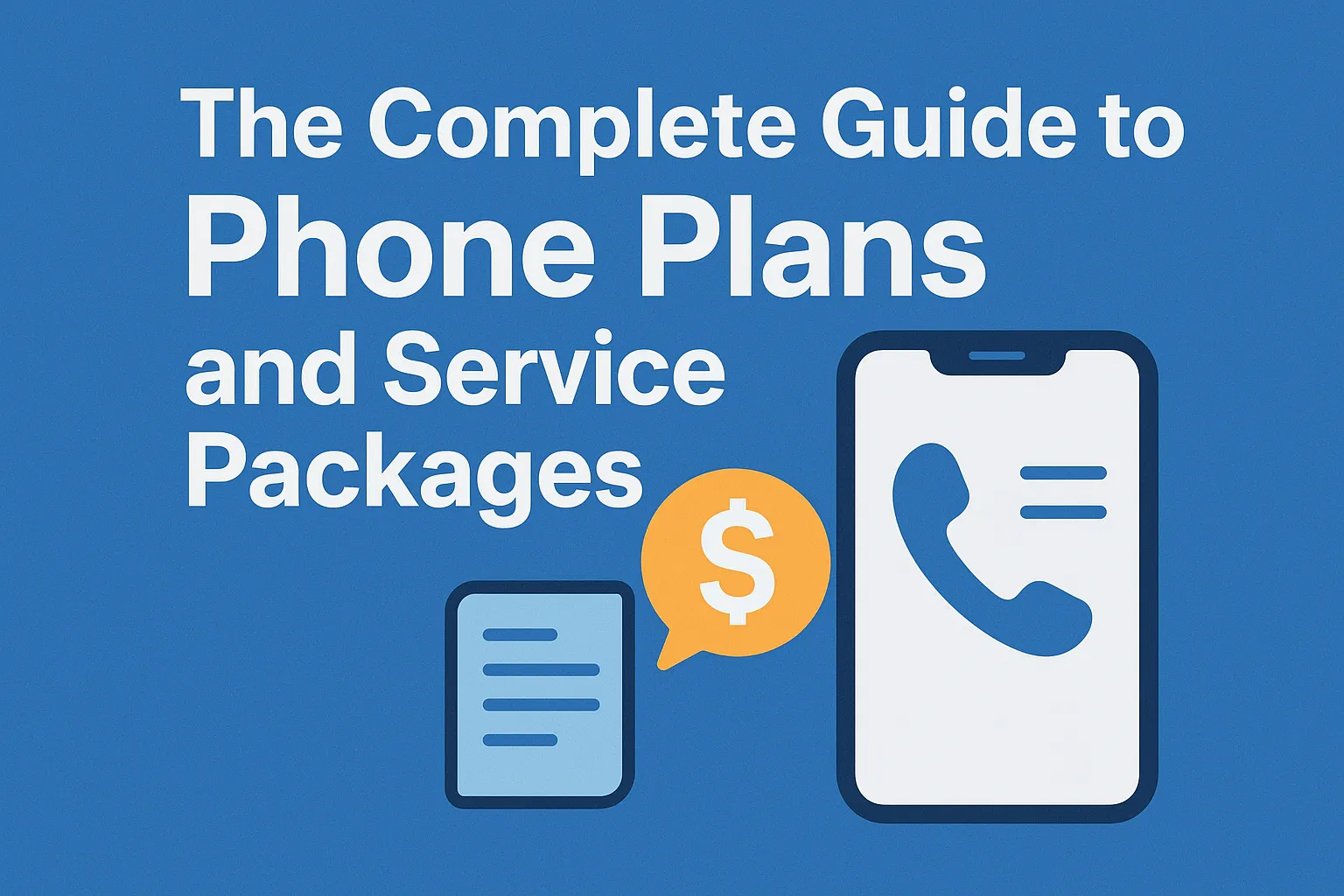The Complete Guide to Phone Plans and Service Packages
Phone plans and service packages form the backbone of mobile communication services today. These offerings from telecommunications companies provide users with various combinations of voice, text, and data services at fixed monthly rates. Understanding what these plans entail is crucial for consumers looking to make informed decisions about their mobile service choices.
 Understanding Phone Plans and Service Packages
Understanding Phone Plans and Service Packages
Phone plans and service packages form the backbone of mobile communication services today. These offerings from telecommunications companies provide users with various combinations of voice, text, and data services at fixed monthly rates. Understanding what these plans entail is crucial for consumers looking to make informed decisions about their mobile service choices.
What Are Phone Plans?
Phone plans, at their core, are service agreements between consumers and mobile carriers. These agreements outline the specific communication services provided, usage limits, and the cost structure. Modern phone plans typically include:
- Voice calling minutes (limited or unlimited)
- Text messaging capabilities (limited or unlimited)
- Mobile data allowances (measured in gigabytes or unlimited)
- Access to the carrier's network infrastructure
Phone plans generally fall into two primary categories: postpaid and prepaid. Postpaid plans involve billing customers after service usage, usually on a monthly basis. These plans often require credit checks and contractual commitments. Prepaid plans, conversely, require payment before service usage, offering greater flexibility without contractual obligations.
What Are Service Packages?
Service packages represent bundled offerings that combine various telecommunications services into a single plan. These packages frequently include:
- Mobile phone service
- Home internet connectivity
- Television services
- Landline telephone service
The bundling strategy allows carriers to provide multiple services at a potentially lower cost than purchasing each service individually. Service packages appeal to consumers seeking simplicity in billing and service management.
The Evolution of Mobile Plans
Mobile phone plans have evolved significantly since their inception. Early plans focused primarily on voice minutes, with text messaging and data capabilities emerging later as technology advanced. The historical progression includes:
- 1980s-1990s: Primarily voice-focused plans with high per-minute charges
- Early 2000s: Introduction of text messaging packages and basic data services
- Late 2000s: Emergence of smartphone-friendly plans with substantial data allowances
- 2010s: Shift toward unlimited talk and text with tiered data pricing
- Present day: Emphasis on unlimited data plans with varying speeds and streaming quality options
This evolution reflects changing consumer needs and technological capabilities, with modern plans increasingly data-centric as voice and texting become commoditized features.
Advantages of Phone Plans and Packages
Phone plans and comprehensive service packages offer numerous benefits that have contributed to their widespread adoption. Understanding these advantages helps consumers evaluate whether bundled offerings align with their communication needs.
Cost Efficiency Through Bundling
One of the most compelling advantages of service packages is cost efficiency. Bundling multiple services often results in lower overall costs compared to purchasing each service separately. This cost efficiency manifests in several ways:
- Reduced per-service rates when combined in packages
- Shared resources across services (e.g., data pools for multiple lines)
- Promotional discounts exclusively available for bundled services
- Elimination of multiple setup or activation fees
Studies suggest consumers can save between 10-30% through proper bundling, though actual savings vary based on specific package components and provider policies.
Simplified Billing and Management
Service packages streamline the administrative aspects of telecommunications services. This simplification presents tangible benefits:
- Consolidated monthly statements rather than multiple bills
- Single customer service point of contact for all services
- Unified payment processing and due dates
- Centralized account management through a single portal or app
This integration reduces the cognitive load associated with managing multiple service providers, payment schedules, and account credentials.
Enhanced Service Integration
Modern service packages offer technical integration advantages that enhance the user experience:
- Cross-platform functionality between mobile and home services
- Unified messaging across devices and service types
- Seamless transition between Wi-Fi and cellular networks
- Integrated entertainment options across mobile and home platforms
This integration creates a more cohesive digital ecosystem, allowing for continuity of experience regardless of which component of the service package is being utilized.
Loyalty Benefits and Rewards
Carriers frequently offer enhanced loyalty programs and rewards for customers who choose bundled services:
- Priority customer service for package subscribers
- Earlier access to device upgrades and new technologies
- Accumulation of loyalty points redeemable for accessories or service credits
- Exclusive access to content or features not available to single-service customers
These loyalty mechanisms encourage long-term relationships between consumers and service providers while adding value beyond the core telecommunications services.
Key Considerations When Choosing a Plan
Selecting the appropriate phone plan or service package requires careful evaluation of several factors. This systematic approach ensures alignment between service offerings and individual needs.
Analyzing Your Usage Patterns
Understanding personal usage patterns forms the foundation of effective plan selection. Key metrics to analyze include:
- Voice usage: Average monthly call minutes, including typical call duration and frequency
- Texting habits: Monthly SMS and MMS volume, including group messaging activity
- Data consumption: Average monthly data usage across applications, particularly for streaming, navigation, and social media
- Usage variability: Consistency or fluctuation of usage patterns month-to-month
Most carriers provide tools to analyze historical usage, while third-party applications can track current consumption patterns. This analysis prevents overpaying for unnecessary features while ensuring sufficient resources for typical usage.
Network Coverage and Quality
Even the most feature-rich plan provides little value without reliable connectivity. Coverage considerations include:
- Geographic coverage in frequently visited locations (home, work, commute routes)
- Indoor reception quality, particularly in buildings with potential signal challenges
- Rural coverage for those who travel beyond metropolitan areas
- Network congestion during peak usage times
- Availability of fallback networks (3G/4G) in areas lacking the latest technology
Coverage maps provided by carriers offer general guidance, though user reviews and independent testing often provide more realistic assessments of actual network performance.
Contract Terms and Flexibility
Contractual obligations significantly impact the long-term value of phone plans. Key considerations include:
- Contract duration requirements (month-to-month vs. 1-2 year commitments)
- Early termination fees and their proration structure
- Ability to modify plan features mid-contract
- Equipment installment plans tied to service contracts
- Contract auto-renewal policies and notification practices
The trend toward contract-free options provides greater flexibility but may sacrifice certain pricing advantages or device subsidies associated with longer commitments.
Device Compatibility and Upgrade Options
Phone plans often incorporate device-related elements that merit consideration:
- Network technology compatibility (CDMA vs. GSM, specific 5G bands)
- Device financing options and interest rates
- Early upgrade eligibility and associated costs
- Bring-your-own-device policies and potential discounts
- Insurance offerings and replacement programs
The increasing cost of flagship devices makes these factors increasingly significant in the total cost calculation of mobile services.
Family Plan Considerations
Shared plans introduce additional factors for evaluation:
- Per-line costs and volume discounts
- Allocation mechanisms for shared data
- Parental controls and usage monitoring capabilities
- Line addition and removal flexibility
- Variable feature sets for different family members
Family plans often provide substantial savings compared to individual lines, though they require coordination among users to avoid overages or resource conflicts.
Pricing Comparison and Hidden Costs
Effective comparison of phone plans requires looking beyond advertised monthly rates to understand the complete cost structure. This comprehensive approach reveals the true expense of mobile services.
Understanding the Base Price Structure
Advertised plan prices typically represent only a portion of the actual cost. Base pricing elements include:
- Core service charges for talk, text, and data
- Line access fees for each device on the account
- Equipment installment payments
- Autopay and paperless billing discounts
- Multi-line discounts for family or group plans
When comparing plans, normalizing these components across providers ensures an accurate assessment of relative value. Some carriers prominently advertise post-discount pricing, while others present pre-discount rates, creating apparent price disparities that may not reflect actual costs.
Regulatory Fees and Taxes
Government-mandated charges significantly impact the final bill amount. These non-negotiable additions include:
- Federal Universal Service Fund contributions
- State and local telecommunications taxes
- 911 service fees
- Regulatory cost recovery charges
- Administrative fees
These fees typically add 10-25% to the advertised rate, with substantial variation based on geographic location. While carriers must collect these fees, their disclosure practices differ, with some incorporating estimates in advertised pricing and others revealing them only at checkout or on the first bill.
Overage Charges and Usage Penalties
Exceeding plan limits can trigger substantial additional charges:
- Data overage fees (typically $10-15 per additional gigabyte)
- International calling rates outside plan allowances
- Premium service access (directory assistance, operator services)
- Roaming charges in certain areas
- Tethering or hotspot fees if not included in the base plan
The shift toward unlimited plans has reduced some overage risks, though "unlimited" often involves throttling after certain usage thresholds rather than true unlimited high-speed access.
Activation and One-Time Fees
Initial setup costs can significantly impact first-year expenses:
- Activation fees per line ($20-45 typical)
- SIM card charges
- Device upgrade fees
- In-store setup assistance charges
- Expedited shipping for devices or accessories
While these fees are sometimes waived during promotional periods, they represent standard revenue sources for most carriers and should be factored into comparison calculations.
Early Termination and Contract Breakage Costs
Changing plans or carriers before contract completion triggers penalties:
- Early termination fees, often prorated based on remaining contract months
- Device payoff requirements when financing through the carrier
- Repayment of promotional credits or discounts
- Restocking fees for returned devices
- Port-out fees when transferring numbers to new carriers
The financial implications of early contract termination can be substantial, emphasizing the importance of carefully evaluating initial commitments.
Strategies for Making the Right Choice
Selecting the optimal phone plan requires a methodical approach that balances cost considerations with service requirements. These strategies help navigate the complex decision-making process.
Conducting a Needs Assessment
Before comparing specific plans, a thorough self-evaluation establishes clear requirements:
- Documenting typical monthly usage across services (voice, text, data)
- Identifying must-have features versus nice-to-have options
- Mapping frequent travel patterns to evaluate coverage requirements
- Assessing device preferences and upgrade timelines
- Determining budget constraints and price sensitivity
This assessment creates a personalized framework for evaluating options, preventing decision paralysis from too many choices or features.
Leveraging Comparison Tools
Various resources streamline the comparison process:
- Carrier-provided plan comparison charts
- Independent comparison websites that normalize plan features
- User review platforms that provide real-world service assessments
- Coverage mapping tools that visualize network availability
- Bill analysis services that recommend optimal plans based on actual usage
These tools provide objective data points that complement carrier marketing materials, offering a more balanced view of available options.
Negotiation Techniques
Many plan aspects remain negotiable, particularly for existing customers:
- Requesting retention offers when considering carrier changes
- Timing negotiations near contract end dates for maximum leverage
- Citing competitor offers to prompt matching or better deals
- Asking specifically about unadvertised plans or promotions
- Seeking waiver of activation or upgrade fees
Carriers typically allocate retention budgets to prevent customer defection, creating opportunities for customized offers that may not be publicly advertised.
Timing Purchase Decisions
Strategic timing can yield significant savings:
- Seasonal promotions (back-to-school, holiday shopping periods)
- New device launch periods when carriers offer special incentives
- End-of-quarter promotions tied to carrier sales targets
- Competitive response periods following major announcements from rival carriers
- Weekday versus weekend variations in promotional availability
Patience often yields substantial rewards, as carriers regularly cycle through promotional periods to drive new activations and upgrades.
Trial Periods and Satisfaction Guarantees
Risk mitigation strategies protect against unsuitable plan selection:
- Carrier satisfaction guarantees (typically 14-30 days)
- Network test drive programs that allow service sampling
- Short-term prepaid options to evaluate service quality
- Gradual migration strategies when moving multiple lines
- Return policies for associated devices and accessories
These approaches provide practical experience with services before making long-term commitments, reducing the likelihood of dissatisfaction after the cancellation window closes.
Ongoing Plan Maintenance
Plan selection represents the beginning rather than the end of optimization:
- Regular usage analysis to identify changing patterns
- Periodic market comparison to identify emerging better options
- Awareness of grandfathered plan advantages before making changes
- Monitoring for upsell opportunities that may not deliver value
- Scheduled carrier check-ins to identify loyalty offers
Treating plan selection as an ongoing process rather than a one-time decision ensures continued alignment between services and needs as both evolve over time.
Future Trends in Phone Plans
The telecommunications landscape continues to evolve, with several emerging trends likely to reshape phone plans and service packages in coming years.
5G Integration and Pricing
The ongoing deployment of 5G networks is fundamentally changing service structures:
- Speed-tiered pricing replacing data-quantity tiers
- Application-specific service guarantees (gaming, video, IoT)
- Premium pricing for millimeter wave access in dense urban areas
- Integration of edge computing capabilities in premium plans
- New device requirements driving plan and device bundling
As 5G becomes the standard rather than a premium option, plan structures will likely emphasize service quality differentiation rather than basic connectivity.
eSIM and Multi-Carrier Flexibility
Embedded SIM technology enables new service models:
- Dynamic carrier switching based on coverage or pricing
- On-demand temporary service activation
- Specialized plans for secondary devices
- Simplified international service without physical SIM changes
- Reduced switching friction between carriers
This technology potentially disrupts traditional carrier lock-in models, creating more fluid customer relationships and increasing competitive pressure.
Integration with Other Services
Telecommunications increasingly serves as a platform for broader service delivery:
- Bundling with content streaming services
- Integration with smart home ecosystems
- Financial service partnerships (banking, payment processing)
- Health and wellness monitoring capabilities
- Education and professional development offerings
This expansion beyond core connectivity potentially redefines value propositions while creating new revenue streams for carriers facing commoditization of basic services.
Sustainability and Ethical Considerations
Environmental and social considerations are influencing plan structures:
- Carbon-neutral service options with premium pricing
- Device recycling incentives integrated into plan pricing
- Transparent supply chain certifications
- Digital inclusion initiatives for underserved populations
- Energy efficiency disclosures and commitments
These factors increasingly influence consumer decision-making, particularly among younger demographics prioritizing corporate responsibility.
Conclusion
Navigating the complex landscape of phone plans and service packages requires a combination of self-awareness, market knowledge, and strategic thinking. By understanding personal usage patterns, identifying true costs beyond advertised rates, and employing thoughtful negotiation strategies, consumers can secure arrangements that balance cost-effectiveness with service quality.
The telecommunications industry continues to evolve rapidly, with technological advances like 5G and eSIM creating both new opportunities and potential complexities. Staying informed about these developments while maintaining focus on fundamental needs rather than marketing hype enables optimal decision-making in this essential service category.
Ultimately, the ideal phone plan represents a personalized solution rather than a universal recommendation. By applying the frameworks and strategies outlined in this guide, consumers can confidently evaluate options and select services that align with their unique communication requirements, financial constraints, and usage habits.











